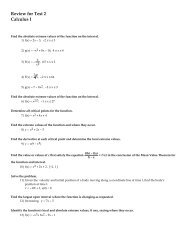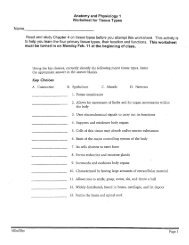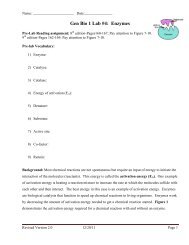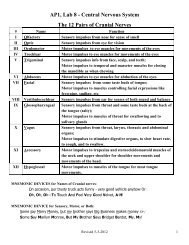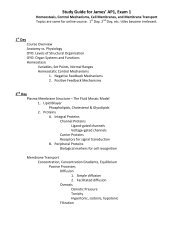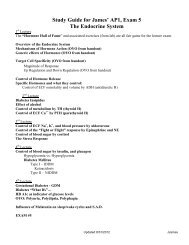Lab 7: Molluscs & Echinoderms - Brazosport
Lab 7: Molluscs & Echinoderms - Brazosport
Lab 7: Molluscs & Echinoderms - Brazosport
Create successful ePaper yourself
Turn your PDF publications into a flip-book with our unique Google optimized e-Paper software.
<strong>Echinoderms</strong> are radially symmetrical animals that are only found in the sea (there are none on land or<br />
in fresh water). <strong>Echinoderms</strong> mean "spiny skin" in Greek. Many, but not all, echinoderms have spiny skin.<br />
There are over 6,000 species. <strong>Echinoderms</strong> usually have five appendages (arms or rays), but there are some<br />
exceptions.<br />
Radial symmetry means that the body is a hub, like a bicycle wheel, and tentacles are spokes coming<br />
out of it (think of a starfish). As larvae, echinoderms are bilaterally symmetrical. As they mature, they become<br />
radially symmetrical. Most adult echinoderms live on the bottom of the ocean floor. Many echinoderms have<br />
suckers on the ends of their feet that are used to capture and hold prey, and to hold onto rocks in a swift current.<br />
Sea Stars<br />
Sea stars (group name Stelleroidea) are sometimes called starfish, however<br />
they are not really fish (they lack both vertebrae and fins). There are two subtypes<br />
of sea stars:<br />
2<br />
Asteroids include: true sea stars and sun stars (A)<br />
Ophiuroids include: brittle stars (B) and basket stars (C)<br />
The differences between the two sub-types lie in how the arms connect to the<br />
central disk. Ophiuroids have arms that do not connect with each other. There<br />
is a distinct boundary between arm and central disk. Asteroids have arms that<br />
are connected to each other. Also, it is harder to tell with asteroids where the<br />
central disk ends and the arms begin. The sea star's top surface (aboral) is very<br />
spiny, to resist predation. If you look very closely, however, you will notice<br />
that there are different types of growths on the surface. Some bumps are used<br />
to absorb oxygen, they are called dermal branchiae. Pedicellaria are<br />
pincher-like organs used to clean the surface of the skin. Barnacle larvae could<br />
land on a sea star and start growing if it were not for these organs.<br />
How Do Sea Stars Move?<br />
Each sea star had hundreds of tiny feet on the bottom of each ray. These are tube feet, or podia. These tiny feet<br />
can be filled with sea water. The vascular system of the sea star is also filled with sea water. By moving water<br />
from the vascular system into the tiny feet, the sea star can make a foot move by expanding it. This is how sea<br />
stars move around. Muscles within the feet are used to retract them. Each ray of a sea star has a light sensitive<br />
organ called an eyespot. Though it cannot see nearly as well as we do, sea stars can detect light and its general<br />
direction. In other words, they have some idea of where they are going.<br />
B<br />
C<br />
A



